spare tire AUDI A5 COUPE 2012 Owners Manual
[x] Cancel search | Manufacturer: AUDI, Model Year: 2012, Model line: A5 COUPE, Model: AUDI A5 COUPE 2012Pages: 316, PDF Size: 78.59 MB
Page 5 of 316
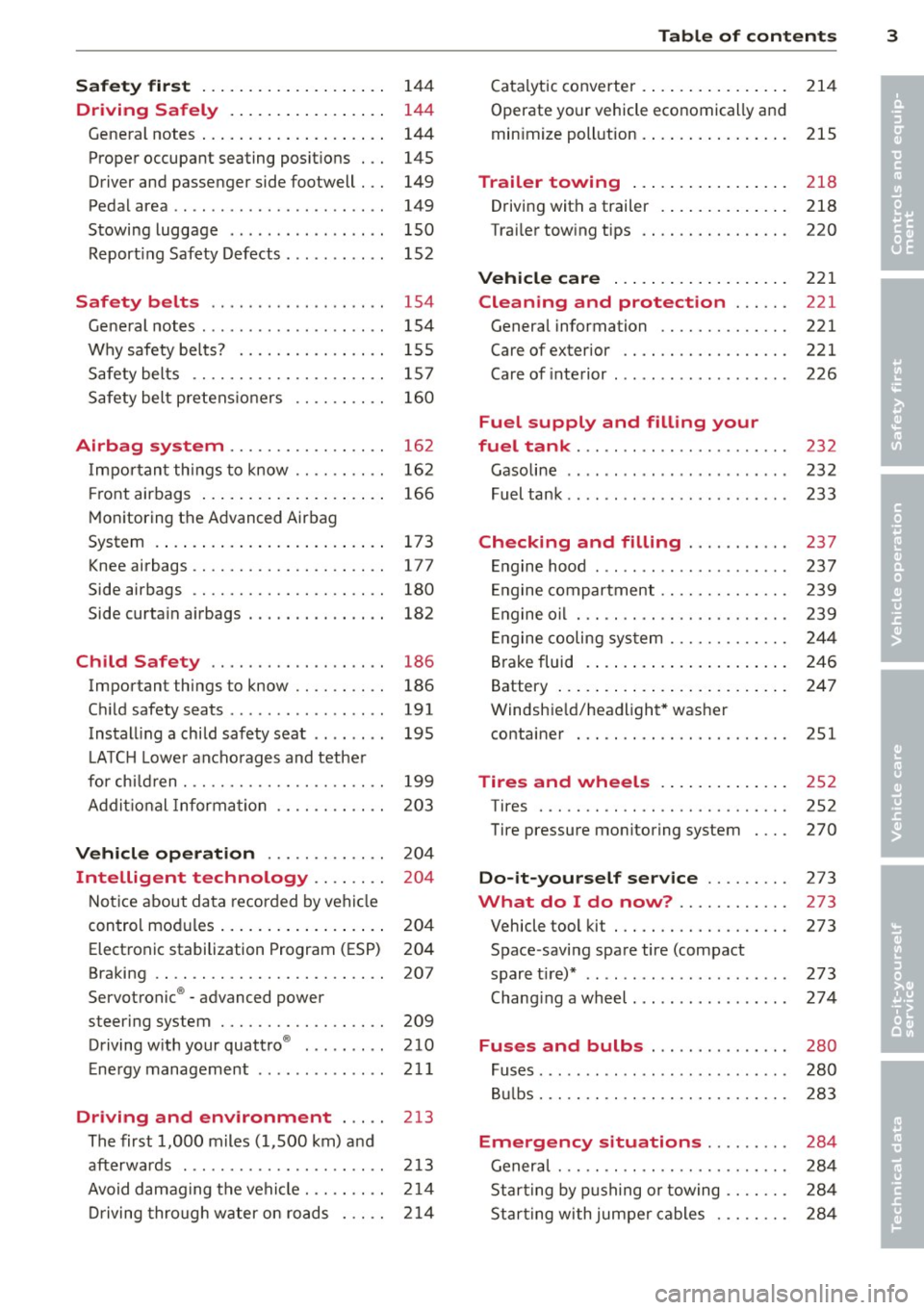
Safet y fir st ..... .... ... .. .. .. . .
Driving Safely .. .... ... .. .. .. . .
General notes ... ...... ... .. .. .. . .
Proper occupant seating posit ions . . .
Driver and passenger side footwell . . .
Pedal area .. .. .............. ... . .
Stowing luggage ... ...... .. .. .. . .
R eport ing Safety Defects . ......... . 1
4 4
144
144
145
149
149 150
152
Safety belts . . . . . . . . . . . . . . . . . . . 154
General notes . . . . . . . . . . . . . . . . . . . . 154
Why safety bel ts? . . . . . . . . . . . . . . . . 1 55
Safety belts . . . . . . . . . . . . . . . . . . . . . 157
Safety belt p re tens ioners . . . . . . . . . . 160
Airbag system . . . . . . . . . . . . . . . . . 16 2
I mpor tant th ings to know . . . . . . . . . . 16 2
Fr ont airbags . . . . . . . . . . . . . . . . . . . . 166
M onitoring the Advanced Airbag
System . . . . . . . . . . . . . . . . . . . . . . . . . 173
Knee airbags . . . . . . . . . . . . . . . . . . . . . 177
Side airbags . . . . . . . . . . . . . . . . . . . . . 180
Side curta in a irbags . . . . . . . . . . . . . . . 182
Ch ild Safety . . . . . . . . . . . . . . . . . . . 186
Important things to know . . . . . . . . . . 186
C hi ld safety seats . . . . . . . . . . . . . . . . . 191
Install ing a chi ld safety seat . . . . . . . . 195
L A TC H L ower ancho rages and tethe r
fo r ch ild ren . ............. .... .. .. 199
Addit io nal Informa tion 20 3
Vehicle operation . . . . . . . . . . . . . 204
Intelligent technology . . . . . . . . 204
N ot ice about da ta recorded by vehi cle
control mod ules . . . . . . . . . . . . . . . . . . 2 04
Electron ic stabilization Program (ESP) 204
Braking . . . . . . . . . . . . . . . . . . . . . . . . . 207
Servot ronic ® - advanced power
steering system . . . . . . . . . . . . . . . . . . 209
Driving w ith your quatt ro ® . . . . . . . . . 210
Ene rgy management . . . . . . . . . . . . . . 21 1
Driving and environment . . . . . 213
The first 1,000 m iles (1,500 km) a nd
afterwards . . . . . . . . . . . . . . . . . . . . . . 2 13
Avoid damaging the vehicle. .. .. .. .. 2 14
Dr iving thro ugh w ater o n roads . . . . . 2 14
Table of contents 3
Cata lyt ic converter . .. .. .. ..... ... .
Operate yo ur vehicle economically and
min imize poll ution . .. .. ... .... ... .
Trailer towing .... .. .. ..... ... .
Driving with a trailer . .. ..... ... .. .
Trai ler tow ing tips 214
215
218
218
220
Vehicle care
. . . . . . . . . . . . . . . . . . . 221
Cleaning and protection . . . . . . 221
General information . . . . . . . . . . . . . . 221
Care of exterior . . . . . . . . . . . . . . . . . . 221
Care of interior . . . . . . . . . . . . . . . . . . . 226
Fuel supply and filling your
fuel tank . . . . . . . . . . . . . . . . . . . . . . .
232
Gasoline . . . . . . . . . . . . . . . . . . . . . . . . 232
Fuel tank . . . . . . . . . . . . . . . . . . . . . . . . 233
Checking and filling . . . . . . . . . . . 237
En gine hood . . . . . . . . . . . . . . . . . . . . . 237
E ngine compartment . . . . . . . . . . . . . . 239
E ngine o il . . . . . . . . . . . . . . . . . . . . . . . 239
E ngine cooling sys tem . . . . . . . . . . . . . 244
Brake fluid . . . . . . . . . . . . . . . . . . . . . . 246
Battery . . . . . . . . . . . . . . . . . . . . . . . . . 247
Windsh ie ld/headligh t* was her
container . . . . . . . . . . . . . . . . . . . . . . . 251
Tires and wheels . . . . . . . . . . . . . . 252
Tires ..... .. .. .. ............... .
Tire pressure monitoring system 252
270
Do-it-yourself service
. . . . . . . . . 273
What do I do now? . . . . . . . . . . . . 273
Vehicle tool kit . . . . . . . . . . . . . . . . . . . 273
Space -saving spare tire (compact
spare t ire)* . . . . . . . . . . . . . . . . . . . . . . 273
Chang ing a wheel. .. . .. .. ..... ... . 274
Fuses and bulbs . . . . . . . . . . . . . . . 280
Fuses ... .. .. .. .. .. . .. .... .... .. . 280
B ulbs. . . . . . . . . . . . . . . . . . . . . . . . . . . 283
Emergency situations . . . . . . . . . 284
Genera l . . . . . . . . . . . . . . . . . . . . . . . . . 28 4
Star ting by p ushing or towing . . . . . . . 28 4
Star ting with jumper cables . . . . . . . . 284
•
•
Page 259 of 316
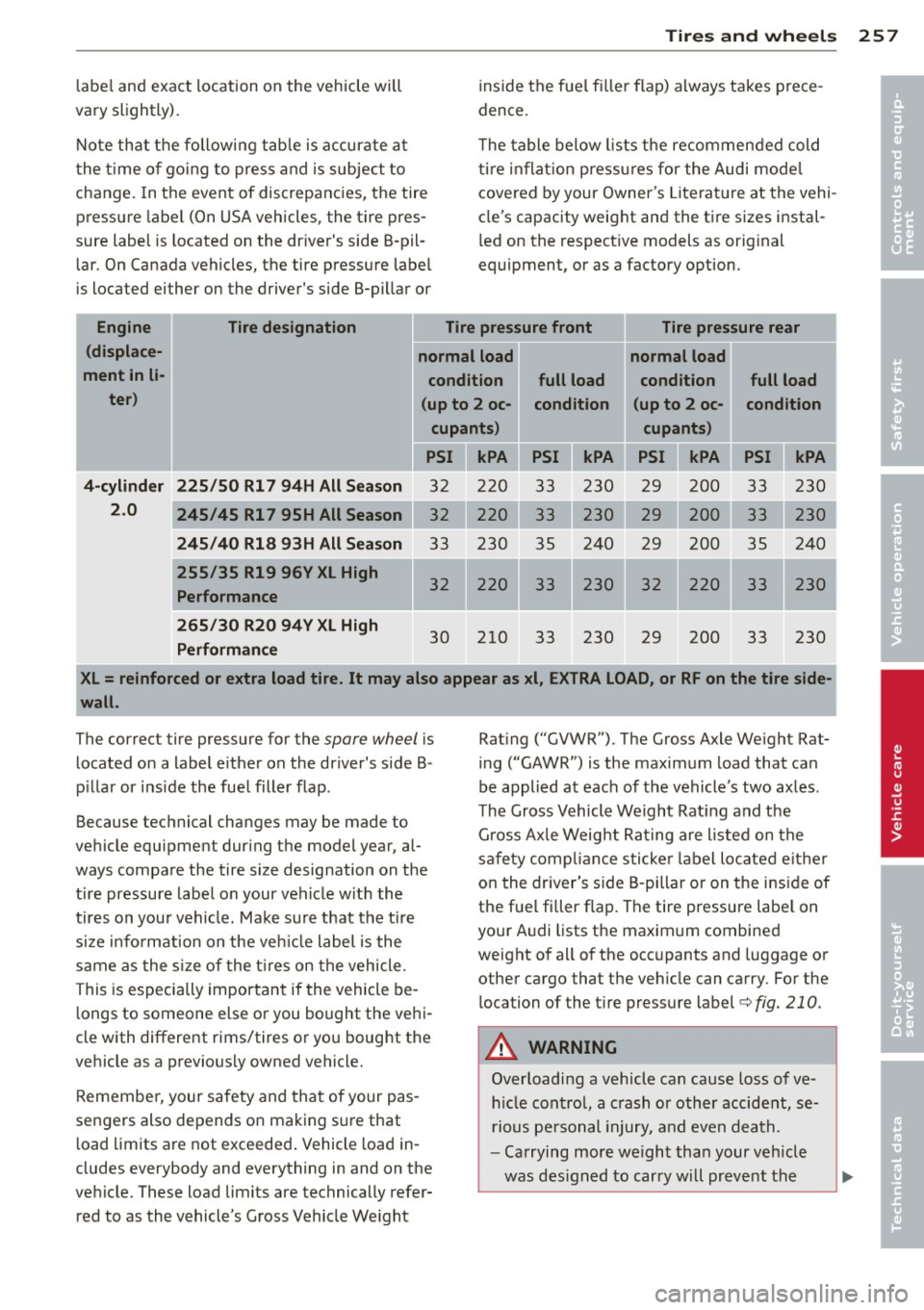
Tires an d wheel s 257
labe l and exact location on the vehicle wi ll
va ry slightly). inside the f
uel fi ller flap) always takes p rece
dence.
Note that the f ollowing tab le is accurate at
t he t ime o f go ing to press and is subject to
change. In the event of discrepancies, the tire
pressure label (On USA vehicles, the tire pres
sure label is located on the dr iver's side B-pil
lar. On Canada vehicles, the tire pre ssure labe l
is located either on the driver's side B-pillar or T
he table below lists the recommended cold
ti re in flat ion p ressu res for the Audi mode l
cove red by your Owner 's Literat ure at the vehi
cle's capacity weight and the t ire sizes instal
l ed on the respect ive models as orig inal
equipment, or as a factory option.
Engine Tire designation Tire pressure front Tire pressure rear
( displace-
normal load normal load
ment in li- condition full load condition
full load
ter) (up to 2 oc-condition (up to 2 oc- condition
cupant s) cupants)
PSI kPA PSI kPA PSI kPA
4-cylinder 225 /50 Rl 7 94H All Season
230
33 230
2
.0
245/45 Rl 7 95H All Season 230
245 /40 R18 93H All S eason 33 230 35 240 29 200 35 240
255 /35 R19 96V XL High 32 220 33 230 32 220 33 230 Performance
265 /30 R20 94V XL H igh
Perfo rmance
30 210 33 230 29 200 33 230
XL= reinforced or extra load tire. It may also appear as xl , EXTRA LOAD, or RF on the tire side
wall.
The correct tire pressure for the spare wheel i s
located on a label e ither on the driver's side B
p illar or ins ide the fuel filler flap .
Because technical changes may be made to
vehicle equ ipment dur ing the model year, a l
ways compare the tire s ize designation on the
tire pressure label on your vehicle w it h the
tires on your veh icle. Ma ke sure that the tire
size info rmation on the ve hicle label is the
s a me as the s ize of the t ires on the vehicle.
This is especia lly important if the vehicle be
l ongs to someone else or you bought the vehi
cle with different rims/tires o r you bought the
vehicle as a previously owned vehicle.
Remember, your safety and that of your pas
sengers also depends on mak ing su re that
l oad limits a re not exceeded . Vehicle load in
cludes everybody and everything in and on the
ve hicle. These load limits are technically refer
red to as the vehicle's G ross Vehicle We ight Rat
ing ("GVWR"). The Gross Axle We ight Rat
ing ("GAWR") is the maximum load that can
be applied at each of the vehicle's two axles .
T he Gross Vehicle Weight Rat ing and the
G ross Ax le Weig ht Rating are listed on the
sa fe ty comp liance sticke r label lo cated e ither
on the dr iver's s ide B-pillar or on the ins ide of
the fue l filler flap. The tire pressure labe l on
your A udi lists the maximum combined
weight of all of the occ upants and luggage or
other cargo that the veh icle can carry . For t he
loca tion of the t ire p ressure label¢
fig. 210.
A WARNING
Overloading a vehicle can cause loss of ve
h icle cont ro l, a c rash or other accide nt, se
rious pe rsonal injury, and even death.
- Ca rrying more we ight than your veh icle
was des igned to carry will prevent the
1
I
•
•
Page 260 of 316
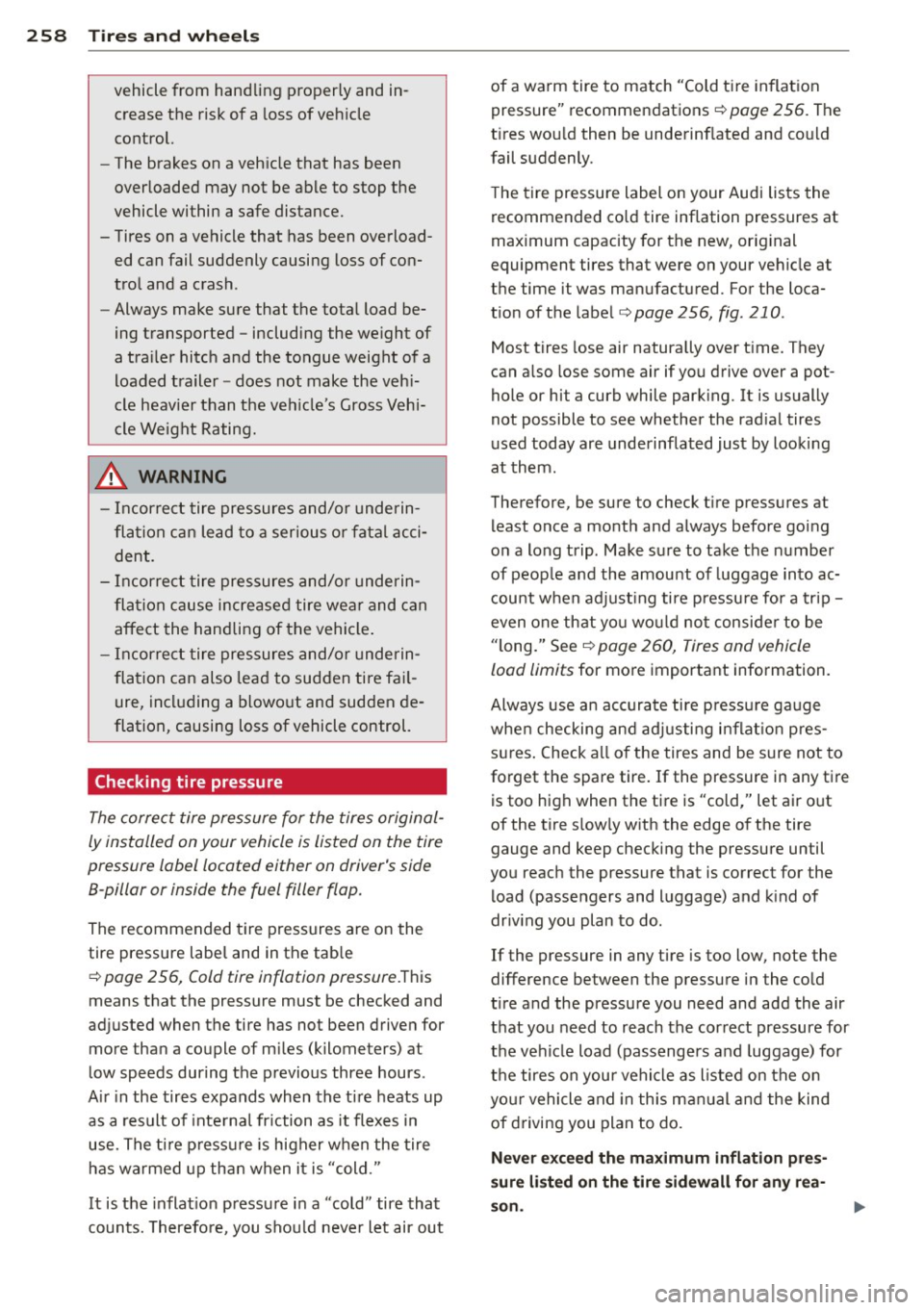
258 Tire s and whee ls
vehicle from handling properly and in
crease the risk of a loss of vehicle
control.
- The brakes on a vehicle that has been
overloaded may not be able to stop the
vehicle within a safe distance.
- Tires on a vehicle that has been overload ed can fail suddenly causing loss of con
tro l and a crash.
- Always make sure that the tota l load be
ing transported -including the weight of
a tra iler hitch and the tongue weight of a
loaded trailer -does not make the veh i
cle heav ier than the veh icle's Gross Vehi
cle Weight Rating.
_& WARNING
- Incorrect tire pressures and/or underin
flation can lead to a serious o r fatal acci
dent.
- Incorrect tire pressures and/or underin
flation cause increased tire wear and can
affect the handling of the vehicle.
- Incorrect tire pressures and/or underin
flation can also lead to sudden tire fai l
ure, including a blowo ut and sudden de
flation, causing loss of vehicle control.
Checking tire pressure
.
The correct tire pressure for the tires original
ly installed on your vehicle is listed on the tire
pressure label located either on driver's side 8-pillar or inside the fuel filler flap.
The recommended tire pressures are on the
tire pressure labe l and in the tab le
¢ page 256, Cold tire inflation pressure .This
means that the pressure must be checked and
adjusted when the tire has not been driven for
more than a couple of miles (kilometers) at
low speeds during the previous three hours .
A ir in the tires expands when the tire heats up
as a result of inte rna l fr iction as it flexes in
use. The ti re p ress ure is higher when the tire
has warmed up than when it is "cold."
It is the inflat ion pressure in a "cold" tire that
counts. Therefo re, you should never let air out of a warm tire to match "Cold tire
inflation
pressure" recommendations ¢
page 256. The
t ires wo uld then be underinf lated and co uld
fail suddenly.
The tire pressure label on your Audi lists the
recommended co ld tire inflation pressures at
maximum capacity for the new, orig inal
equipment tires that were on your vehicle at
the time it was manufactured. For the loca
t ion of the labe l
¢page 256, fig . 210 .
Most tires lose air natura lly over t ime. They
can a lso lose some air if you drive over a pot
hole or hit a curb while park ing. It is usually
not possible to see whether the rad ial tires
used today are underinflated just by look ing
at them.
Therefore, be sure to check t ire pressures at
least once a month and a lways before going
on a long trip . Make sure to take the number
of peop le and the amount of luggage into ac
count when adjust ing ti re pressu re for a trip -
even one that yo u wou ld not consider to be
" long." See
¢ page 260, Tires and vehicle
load limits
for mo re important information.
Always use an accurate tire p ressu re ga uge
when checking and ad justing inflat ion pres
sures . Check a ll of the tires and be s ure not to
forget the spare tire. If the pressure in any tire
is too high when the tire is "cold," let air o ut
of the tire s low ly with the edge of the tire
gauge and keep checking the pressure until
you reach the pressure that is correct for the load (passengers and luggage) and k ind of
dr iv ing you plan to do .
If the pressure in any tire is too low, note the
difference between the pressure in the co ld
t ire and the pressure you need and add the air
that you need to reach the correct pressure for
the vehicle load (passengers and luggage) for
the tires on your vehi cle as listed on the on
yo ur vehicle and in th is m anu al and the kind
of d riving you plan to do.
Ne ver e xceed th e maximum infl ation pre s
sure lis ted o n the tir e side wall for any rea
s on.
Page 261 of 316

Remember that the vehicle manufacturer, not
the tire manufacturer, determines the correct
tire pressure for the t ires on your vehicle .
It is importan t to check the tire pressu re when
the t ires a re cold .
- Read the requ ired ti re p ressure from the tire
pressure label. On USA veh icles, the t ire
pressure label is located on the drive r's side
B-pi llar . On Canada vehicles, the tire pres
s u re label is located either on the driver's
s ide B-pi llar or inside the fue l filler flap . The
t ire press ure label lists the recommended
cold tire inflation pressures for the veh icle
at its max imum capacity weight and the
t ires that were on your vehicle at the time it
was manufactured . Fo r recommended t ire
pressures fo r normal load condit ions, please
see chapter
9page 256.
- T urn the valve stem cap counter-clockwise
to remove it from the tire valve .
- Place the air pressu re ga uge on the valve .
- The tire pressures should only be checked
and adjusted when the tires a re cold . The
s li ghtly raised p ressures of warm tires must
not be reduced.
- Adjust the tire pressure to the load you a re
c a rrying.
- Re install the valve stem cap o n the valve .
When should I check the ti re pres sure ?
The correct tire pressure is espec ially impor
tant at high speeds. The pressure should
therefore be checked at least once a month
and a lways befo re start ing a journey . Do not
forget to check the tire pressure for the spare
wheel.
When should I ad ju st the tire p re ss ures?
Adjust the tire pressure to the load you are
carry ing . After chang ing a wheel
or replacing
wheels you have to adjust the tire pressures
on all wheels. In addition , you must then in it i
alize the new tire pressures in the tire pres
sure mon itor ing system*
9 page 270.
Tire s an d wheel s 259
_& WARNING
Incorrect tire pressures and/or underinfla
tion can lead sudden tire fa ilure, loss of
control, collision, serio us pe rsonal injury
or even death.
- When the
ti] warn ing symbol appears in
the instrument cluster, stop and inspect
the t ires.
- Inco rrect tire pressure and/or underinfla
tion can cause increased tire wea r and
can affect the handling of the vehicle and
s topping ability.
- I nco rrect tire pressures and/or unde rin
f lation can a lso lead to sudden t ire fail
ure, including a blowou t and sudd en de
f lation, ca using loss of veh icle cont ro l.
- T he drive r is responsi ble for the co rrec t
tire pressures for all tires on the veh icle.
The appli cable pressure values a re locat
ed on a sticke r on the dr iver's side B -pil
lar or on the inside of the fuel filler flap.
- On ly when all tires on the vehicle are fil
led to the correct pressure, the t ire pres
sure mon itor ing system * can work cor
rectly.
- The use of incorrect tire pressu re va lues
can lead to acc idents or other damage.
Therefore it is essential that the driver
observe the spec ified t ire pressure values
for the tires and the correct pressures for
the function of th e ti r e p ress ure monito r
ing system*.
- Always inf late tires to the recommended
a nd correct t ire p ress ure before dr iv ing
off.
- Driving with unde rinflated tir es bend
mo re, lett ing t hem get too hot resulting
in tre ad separation, sudden tir e fa ilure
and loss of cont rol.
- Exces sive speed and/overloading can
cause heat b uild- up, s udden tire failure
an d l oss of cont rol.
- If the tire pressure is too low or too high,
the t ires will wear prema turely and the
vehicle wi ll not handle well.
- I f the tire is not fla t and you do not have
to change a wheel immedia tely, drive a t •
•
Page 266 of 316
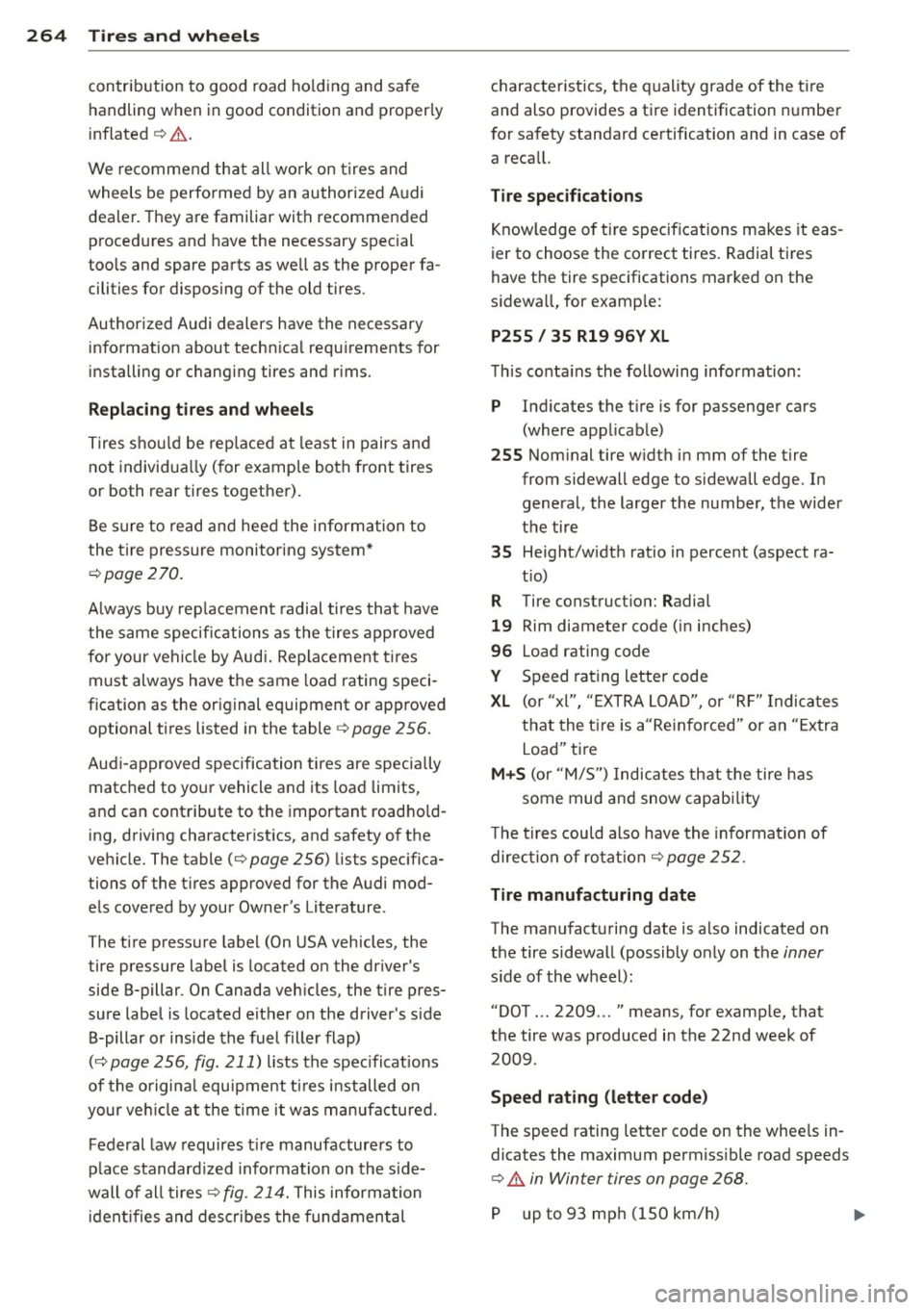
264 Tire s and wheel s
contribution to good road ho lding and safe
handling when in good condition and properly
inflated ¢
,&.
We recommend that all work on tires and
wheels be perfo rmed by an authorized Audi
dea ler. They are familiar with recommended
proced ures and have the necessary spec ial
too ls and spare parts as well as the proper fa
cilities for disposing of the old tires.
Authorized Audi dealers have the necessary information about techn ica l requ irements for
installing or changing tires and r ims.
R eplacing t ires and whe els
Tires sho uld be rep laced at least in pairs and
not individua lly (for examp le both front tires
or both rear tires together).
Be sure to read and heed the information to
the tire pressure monitoring system*
¢page 270.
Always buy rep lacement radial tires that have
the same specifications as the tires approved
for your vehicle by Audi. Replacement t ires
must always have the same load rating speci
fication as the original equipment or approved
optional tires listed in the table
c:> page 256.
Aud i-approved specification ti res are specially
matched to your vehicle and its load limits,
and can contribute to the important road ho ld
ing, driving characteristics, and safety of the
vehicle. The table
(<:>page 256) lists spec ifica
tions of the tires approved for the Audi mod
els covered by your Owner's Literature .
The tire pressure labe l (On USA vehicles, the
tire pressure label is located on the driver's
side B-pillar. On Canada veh icles, the tire pres
sure label is located either on the driver's s ide
B-pillar or inside the fuel filler flap)
(¢page 256, fig. 211) lists the spec ificat ions
of the origina l equipment ti res installed on
your ve hicle a t the time it was manufactured.
Federal law requires t ire manufacturers to
p lace standard ized information on the s ide
wall of all tires
c:> fig. 214. This information
ident ifies and describes the fund amental characteristics, the q
uality grade of the ti re
and also provides a tire identification n umber
for safety standard certification and in case of
a reca ll.
Tire specification s
Knowledge of ti re specif ications makes it eas
ier to choose the co rrect tires. Radial tires
have the tire specifications marked on the
sidewa ll, for examp le:
P255 / 35 R1 9 96Y XL
This conta ins the following information :
P Indicates the tire is for passenger cars
(where app licab le)
2 55 Nom inal tire w idth in mm of the tire
from sidewall edge to sidewall edge. In
general, the larger the number, the wider
the tire
35 Height/w idt h ratio in percent (aspect ra-
t io)
R Tire construct ion: Radial
19 Rim diameter code (in inches)
96 Load rating code
Y Speed rating letter code
XL (or "xl", "E XTRA LOAD", or "RF" Indica tes
that the t ire is a"Re in forced" or an "Extra
Load" ti re
M+S (or "M/5") Indicates that the tire h as
some mud and snow capability
T he tires could also have the information of
direction of rotat io n ¢
page 252.
Tire manuf acturing date
The manufacturing date is also indicated on
the tire sidewall (possibly only on the
inner
side of the wheel):
"DOT ... 2209 ... "means, for example, that
the tire was produced in the 22nd week of
2009.
Speed rating (letter c ode )
The speed rating letter code on the whee ls in
dicates the maximum permiss ible road speeds
c:> & in Winter tires on page 268 .
P up to 93 mph (150 km/h)
Page 268 of 316
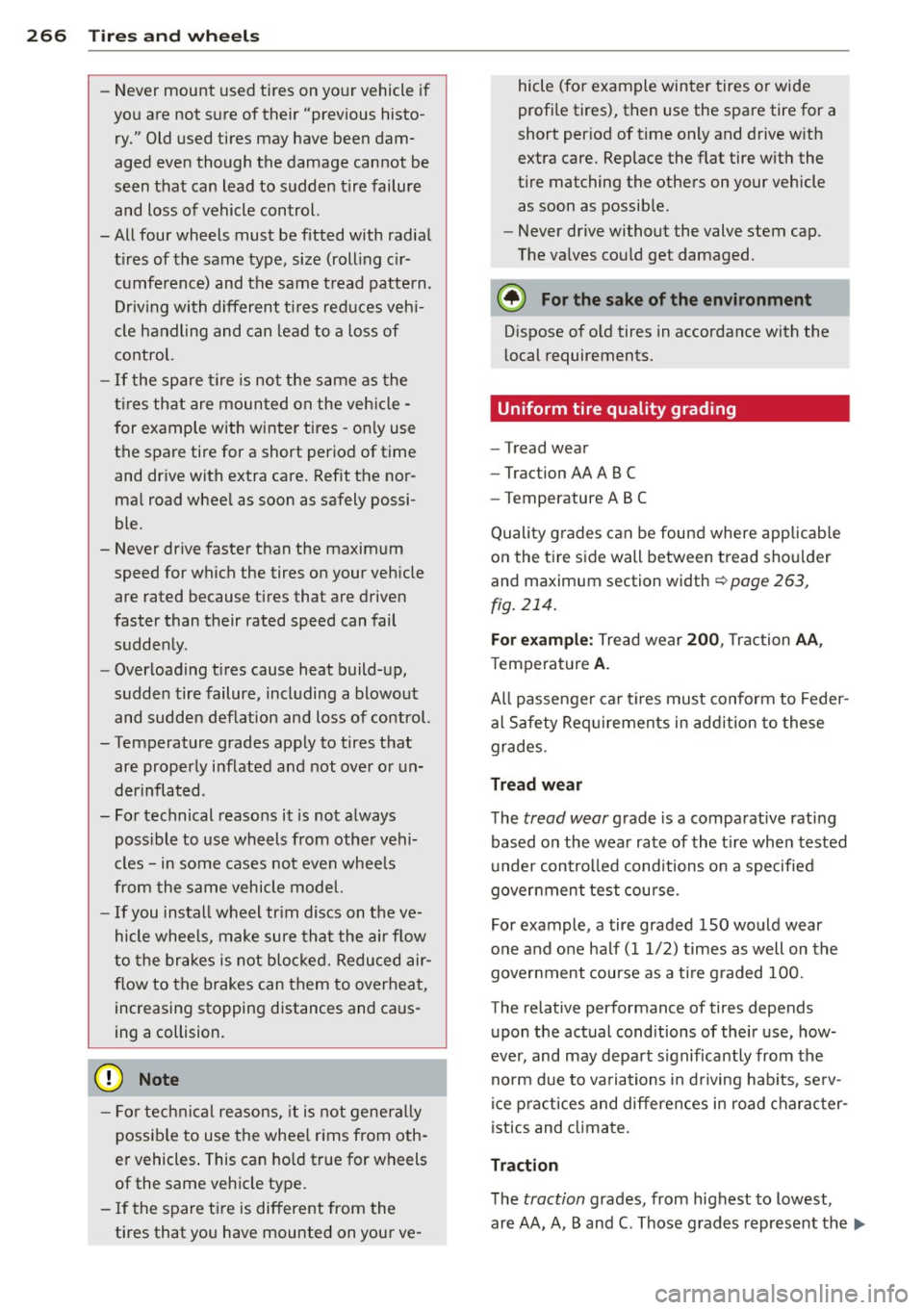
26 6 T ire s and whee ls
- Never mount used tires on yo ur vehicle if
you are not sure of their "previous histo
ry." Old used tires may have been dam
aged even though the damage cannot be
seen that can lead to sudden tire failure
and loss of vehicle control.
- All four wheels must be fitted with radial
tires of the same type, size (roll ing c ir
cumference) and the same tread pattern.
Driv ing with different ti res reduces veh i
cle handling and can lead to a loss of
control.
- If the spare t ire is not the same as the
t ires that are mounted on the veh icle -
f or example with winte r tires -on ly use
the spare tire for a short period of time
and dr ive with extra care. Refit the nor
ma l road whee l as soon as safely possi
ble.
- Never drive faster than the maximum speed for which the tires on your veh icle
are rated because tires that are driven
faster than their rated speed can fail
suddenly.
- Overloading t ires cause heat build-up,
sudden tire failure, including a blowout
and sudden deflation and loss of control.
- Temperature grades apply to tires that
are properly inflated and not over or un
derinflated .
- For technical reasons it is not always
poss ible to use wheels from other vehi
cles -in some cases not even whee ls
from the same vehicle model.
- If you install wheel tr im discs on the ve
hicle whee ls, make sure that the air flow
to the brakes is not blocked. Reduced air
flow to the brakes can them to overheat, increasing stopping distances and caus
ing a collision.
0 Note
- For technical reasons , it is not general ly
possib le to use the whee l rims from oth
er vehicles . This can ho ld true for wheels
of the same vehicle type.
- If the spare tire is different from the
tires that you have mounted on your ve- hicle (fo
r example winter tires or wide
profi le tires), then use the spare tire for a
short period of time only and drive w ith
extra care. Replace the flat tire with the
tire matching the others on your vehicle
as soon as possib le.
- Never drive without the valve stem cap.
The va lves could get damaged.
@ For the sake of the env ironment
D ispose of o ld tires in accordance with the
l ocal requirements.
Uniform tire quality grading
- Tread wear
- Traction AA A B C
- Temperature ABC
Quality g rades can be found where applicab le
on the tire side wall between tread sho ulder
and maximum section width
~ page 263,
fig . 214.
For exampl e: Tread wear 200, Trac tion AA ,
Tempe rature A.
All passenge r car t ires must conform to Feder
al Safety Requirements in add ition to these
grades .
Tread w ear
The tread wear grade is a comparative rating
based on the wear rate of the t ire when tested
under controlled conditions o n a specified
government test course.
For example, a tire graded 150 would wear
one and one ha lf (1 1/2) times as well on the
gover nment course as a ti re g raded 100 .
The relative performance of tires depends upon the actual conditions of their use, how
ever, and may depart s ignificantly from the
no rm due to va riations i n driving hab its, se rv
ice practices and differences in road charac ter
istics and cl imate.
Traction
The traction grades, from highest to lowest,
are AA, A, Band
C. Those grades represent the ..,.
Page 269 of 316
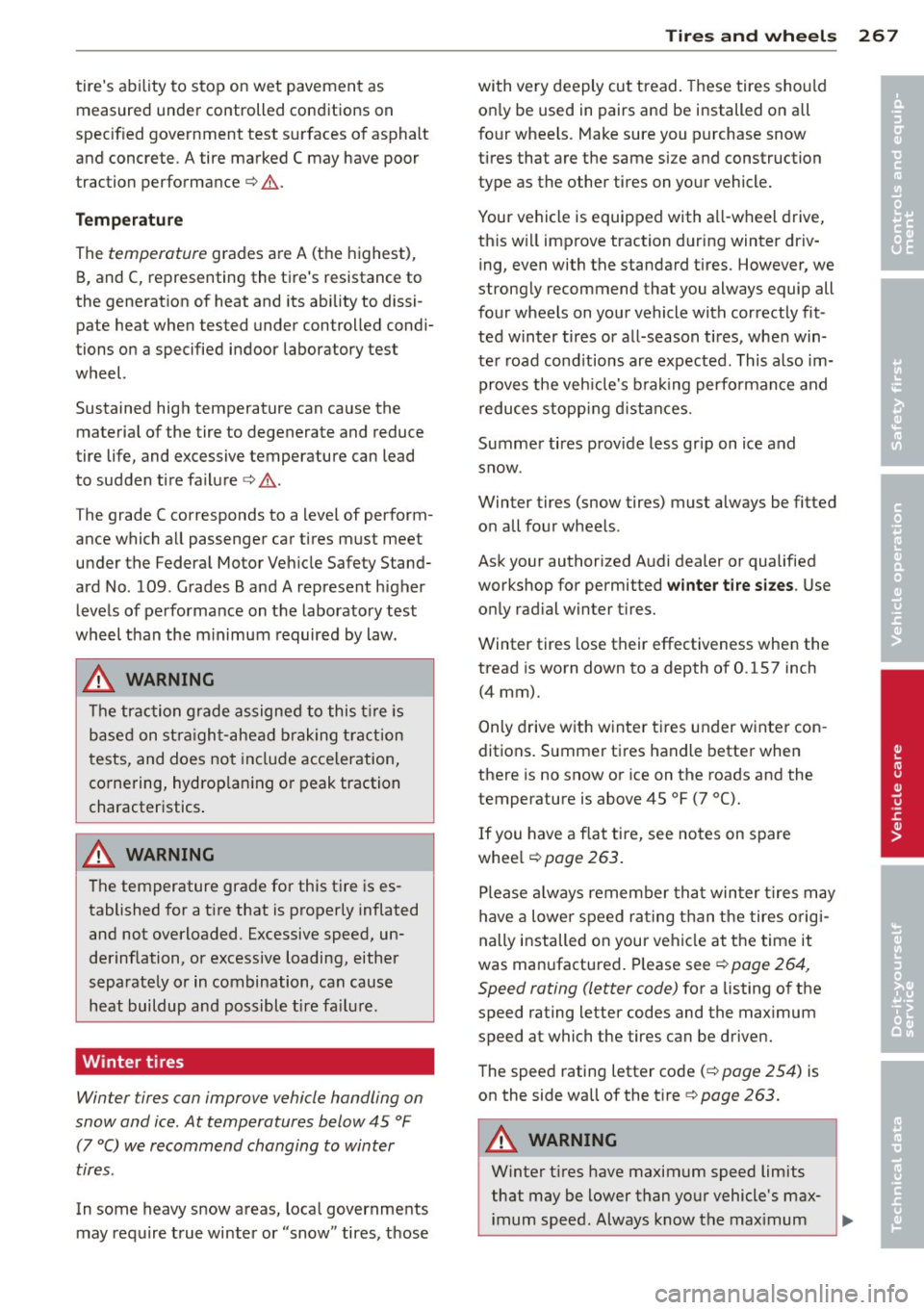
tire's ability to stop on wet pavement as measured under controlled conditions on
specif ied government test surfaces of asphalt
and concrete. A tire marked C may have poor
t raction performance¢ .&,.
Temp eratu re
The temperature grades are A (the highest),
B, and
C, representing the tire's resistance to
the generation of heat and its ability to dissi pate heat when tested under controlled condi
tions on a specified indoor laboratory test
wheel.
Sustained high temperature can cause the material of the tire to degenerate and reduce
tire life, and excessive temperature can lead
to sudden tire failure ¢.&, .
T he grade
C corresponds to a level of perform
ance which all passenger car tires must meet
under the Federa l Motor Veh icle Safety Stand
ard No.
109 . Grades Band A represent higher
levels of performance on the laboratory test
wheel than the m inimum required by law.
.8, WARNING
The trac tion grade assigned to this t ire is
b ase d on stra ight-ahead brak ing t raction
t ests, and does not inclu de acceleration,
co rnering, hydrop laning or peak traction
characteristics .
.8, WARNING
The temperature grade for this tire is es
tablished for a t ire that is properly inflated
and not overloaded . Excessive speed, un
derinflation, or excessive loading, either
separate ly or in combination, can cause
heat buildup and possible ti re fa ilu re.
Winter tires
Winter tires can improve vehicle handling on
snow and ice . At temperatures below 45 °F
(7 °C) we recommend changing to winter
tires.
-
In some heavy snow a reas, loca l governme nts
may require t rue winter or "snow" tires, those
Tires an d wheel s 267
with very deeply cut tread. These tires should
o nl y be used in pairs and be installed o n all
fo ur wheels. Make sure you purchase snow
tires that are the same si ze and construction
type as the other tires on your vehicle.
Your vehicle is equipped with a ll-wheel drive,
th is w ill imp rove traction d uring winter driv
ing, even with the standard tires. However, we
strong ly rec ommend that you always equip all
fou r wheels on you r vehicle with correctly fit
ted w inter t ires or al l-season t ires, when win
te r road cond itions ar e expected . This also im
proves the veh icle's b ra ki ng perfo rman ce and
reduces stopping d ista nces .
Summe r tires p rovide less grip on ice and
snow .
Winter tires (snow tires) must always be fitted
o n all four wheels .
Ask your authorized A udi dealer or qualified
workshop for permitted
winter tire sizes . Use
only rad ial winter t ires.
Winter tires lose their effectiveness whe n the
tread is worn down to a depth of
0.157 inch
(4 mm).
Only drive with winter tires under winte r con
ditions. S ummer t ires handle better when
there is no snow or ice on the roads and the
temperature is above 45 °F (7 °().
If you have a flat t ire, see no tes on spare
whee l ¢ page 263.
P lease alway s remember tha t win ter tire s m ay
have a lowe r speed ra ti ng than the tires orig i
nally installed on your vehi cle at the time it
was man ufactured. Please see ¢page 264,
Speed rating (letter code) for a listing of the
speed rating letter codes and the max imum
speed at which the tires can be driven.
T he spee d rating letter code (¢ page 254) is
on the side wall of the t ire ¢page 263.
.8, WARNING
Winter t ires have maximum speed limits
that may be lower than yo ur vehicle's max-
imum speed . Always know the max imum
~
•
•
Page 272 of 316
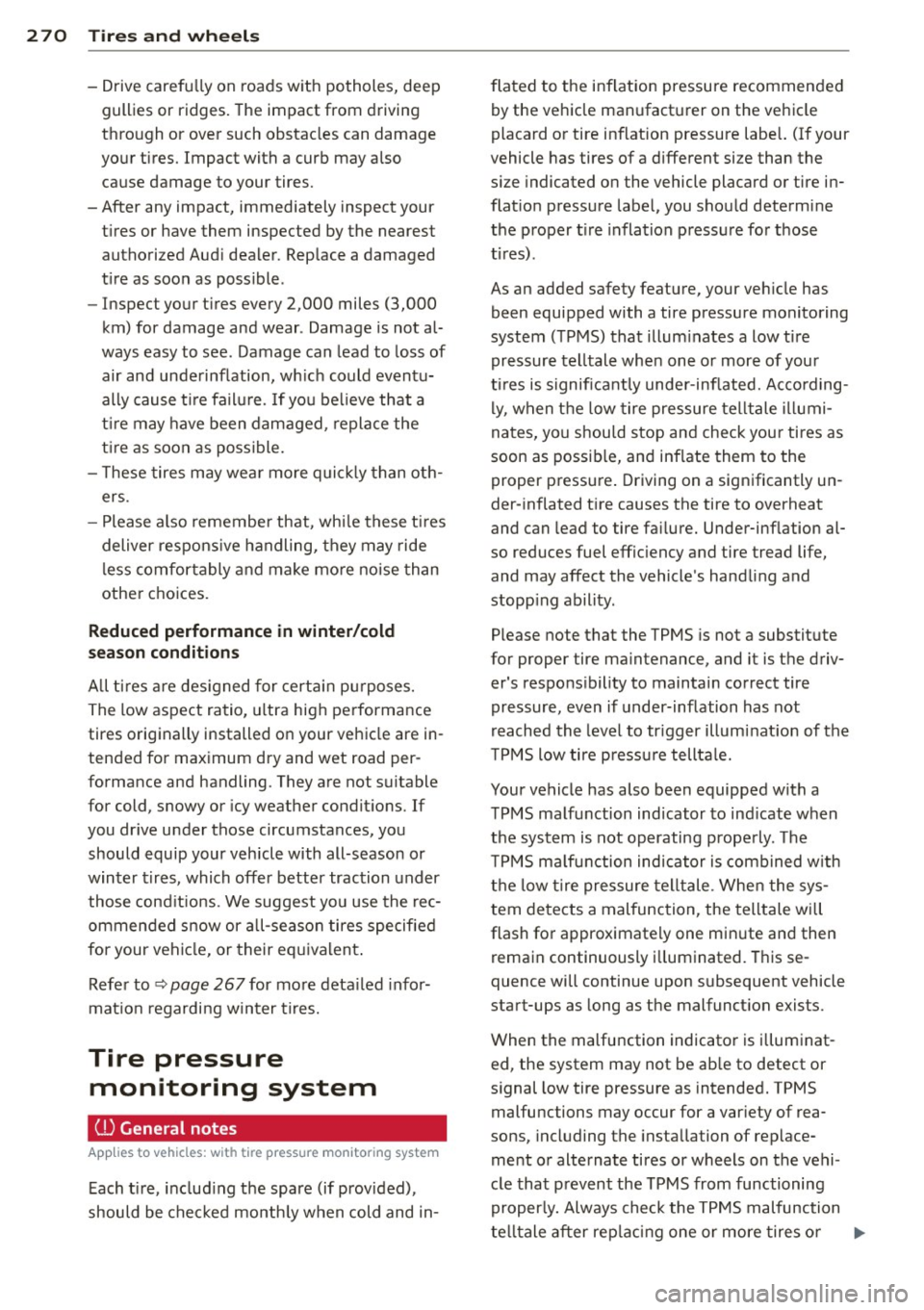
2 70 T ire s and wheel s
- Drive carefu lly on roads with potholes, deep
gullies or ridges. The impact from driving
through or over such obstacles can damage
your tires. Impact with a curb may also
cause damage to your tires.
- After any impact, immediately inspect your tires or have them inspected by the neares t
authorized Aud i dealer. Replace a damaged
t ire as soon as possible .
- Inspect your t ires every 2 ,000 miles (3,000
km) for damage and wear . Damage is not al
ways easy to see . Damage can lead to loss of
air and underinflation, wh ich could eventu
ally cause t ire failu re. If you be lieve that a
t ire may have been damaged, replace the
t ire as soon as poss ible.
- T hese tires may wea r more quick ly than oth
ers.
- Please also remember that, whi le these t ires
deliver respons ive handling, they may ride
less comfortably and make mo re no ise than
othe r choices.
Reduced perf ormance in winter /cold
sea son condit ion s
All ti res are des igned for certa in pu rposes.
The low aspect ratio, u ltra high performance
tires originally installed on your vehicle are in
tended for max imum dry and wet road per
formance and handling . They are not suitable
for cold, snowy or icy weather condit ions. If
you dr ive under those circumstances, you
should equip your vehicle with all-season or
winter tires, which offer better traction under
those cond it ions . We suggest you use the rec
ommended snow or all-season tires specified
for your vehicle, or their equ ivalent .
Refe r to ~
page 267 for more deta iled infor
ma tion regarding w inter tires.
Tire pressure
monitoring system
(l) General notes
App lies to vehicles: with tire pressure monitoring system
Each tire , includ ing the spare (if provided),
should be checked month ly when cold and in- flated to the inflation pressure recommended
by the vehicle manufact urer on the vehicle
placard or tire inflation pressure labe l. (If your
vehicle has tires of a different si ze than the
s ize indicated on the vehicle placard or tire in
flat io n pressure labe l, you shou ld determine
the proper t ire inflation pressu re for those
tires) .
As an added safety feature, your veh icle has
been equipped with a tire pressure monitoring
system ( TPMS) that illum inates a low tire
pressure te lltale when one or more of your
t ir es is significantly under-inflated. Acco rding
ly, when the low tire pressure telltale i llumi
nates, yo u shou ld stop and check your tires as
soon as possib le, and inflate them to the
proper pressure . Driving on a significantly un
der- inflated t ire causes the tire to overheat
and can lead to tire fa ilure. Under-inflation al
so reduces fuel effic iency and tire tread life,
and may affect the vehicle's hand ling and
stopp ing ability .
Please note that the TPMS is not a substitute
for proper tire ma intenance, and it is the driv
er 's respons ibility to maintain correct tire
pressure, even if under-inflation has not
reached the level to tr igger illum inat ion of the
T PMS low tire p ressu re tellta le.
Your vehicle has also been equipped with a
T PMS malfunction ind icator to ind icate when
the system is not operating prope rly . T he
T PMS ma lfunction indicator is combined w ith
t h e low tire pressure te lltale . When the sys
tem detects a malfunction , the telltale will
flash for approximately one min ute and then
remain continuously illuminated. This se
quence will continue upon subsequent vehicle
start-ups as long as the malfunct ion exists .
When the malfunction indicator is illuminat ed , the system may not be ab le to detect or
s ignal low tire pressure as intended. TPMS
malfunctions may occur for a var iety of rea
sons, including the installa tion of replace
ment o r alternate tires or wheels on the vehi
cle that p revent the TPMS from functioning
properly. Always check the TPMS malfunction
te lltale a fter rep lacing o ne or more tires o r .,.
Page 275 of 316
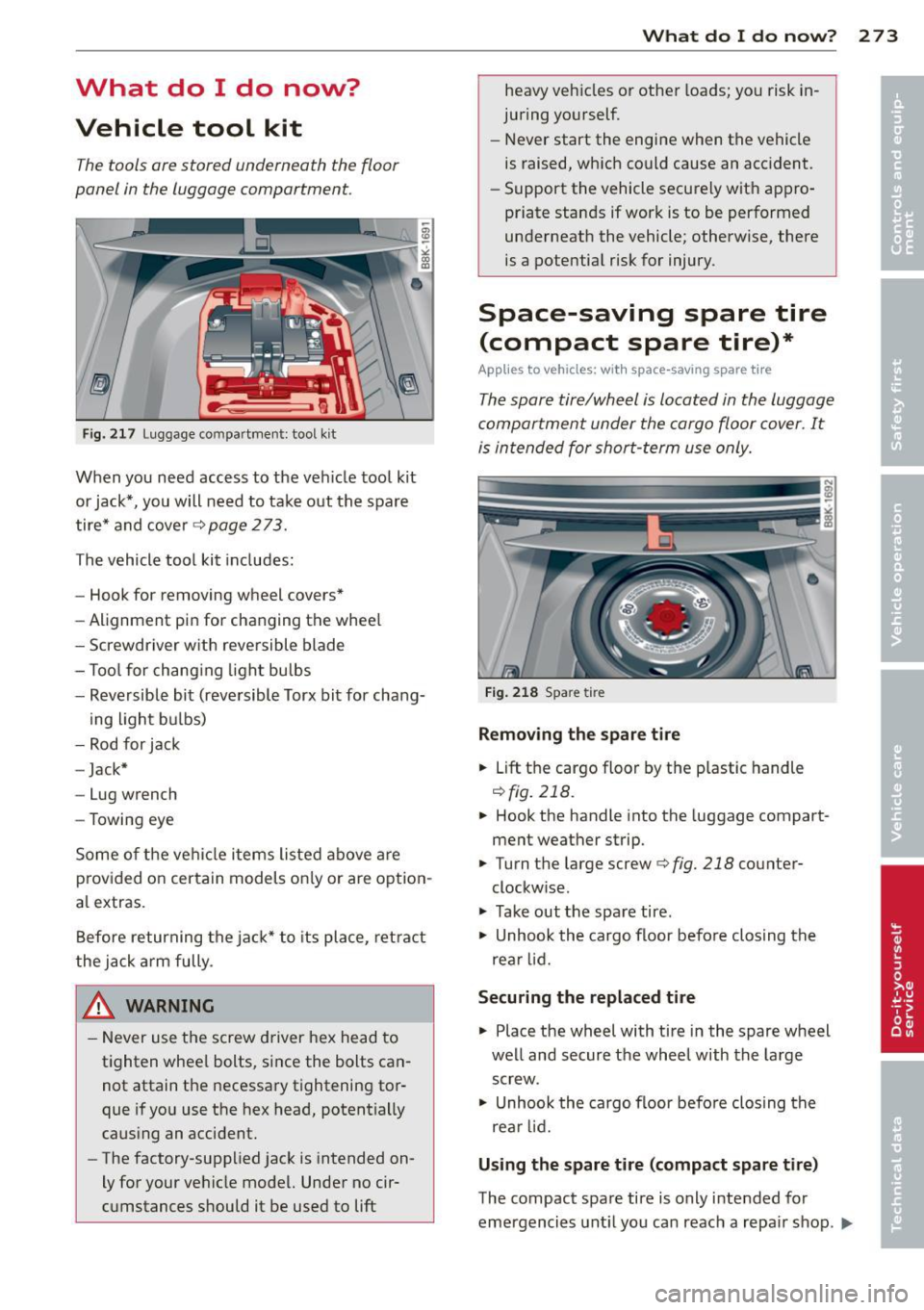
What do I do now?
Vehicle tool kit
The tools ore stored underneath the floor
panel in the luggage comportment.
F ig . 2 17 Lug gage compar tment: tool kit
When you need access to the veh icle tool kit
or jack*, you will need to take o ut the spare
tire* and cover¢
page 2 73.
The vehicle tool kit includes:
- Hook for removing wheel covers*
- Alignment pin for changing the whee l
- Screwdriver w ith reversible blade
- T ool for chang ing light bulbs
- Reversible bit (reve rsible Torx bit for chang-
ing light b ulbs)
- Rod for jack
- Jack*
- Lug wrench
- Towing eye
Some o f the ve hicle items listed above are
p rov ided o n certain models on ly or are opt ion
a l extras.
Before returning the ja ck* to its place, ret ract
the jack a rm fully.
& WARNING
- Never use t he screw driver hex head to
tighten whee l bolts, since the bolts can
not attain the necessary tightening tor
que if yo u use the hex head, potentially
caus ing an accident.
- The factory-supplied jack is intended on
ly for your ve hicle model. Unde r no cir
c u mstances should it be used to
lift
What do I d o now ? 273
heavy ve hicles o r other loads; yo u risk in
juring yo urself.
- Never start the engi ne when the vehicle
is raised, which could cause an acc ident.
- Support the vehicle secu re ly wit h app ro
priate stands if wor k is to be performed
underneath the vehicle; otherwise, there
is a pote ntia l risk for injury .
Space-saving spare tire
(compact spare tire)*
App lies to vehicles: wit h space-saving spare tire
The spore tire/wheel is located in the luggage
comportment under the cargo floor cover. It
is in tended for short -term use only.
Fi g. 2 18 Spa re tire
Removing the spare ti re
.. Lift
th e cargo floo r by the p lastic handle
r:!) fig. 218.
.. Hook the handle into the luggage compart
ment weather strip.
.. Turn t he large screw¢
fig. 218 counter
clockw ise .
.. Take out the spare tire .
.. Unhook the cargo floor befo re clos ing the
re ar l id.
Securing the repl aced tire
.. Place the wheel with tire in the spare wheel
we ll and secure the wheel with the large
screw.
.. Unhook the cargo floor befo re closing t he
re ar lid .
Using the spare tire (compact spare tire)
The compact spa re tire is only i ntended for
emergencies unt il you ca n reach a repa ir shop .
l)JI,
Page 276 of 316

274 What do I do no w?
Replace it as quickly as possible with a stand
ard whee l and tir e.
There are some restric tions on the use of the
compact spare t ire . T he compact spare t ire
has been designed specifically fo r you r type of
vehicle . It must not be swapp ed with a com
pact spare t ire from another type of veh icle .
Snow cha in s
For technical reasons, the use of snow chains
on the compact spare tire is
not p ermitt ed .
If you do have to dr ive with snow cha ins and a
front tire fails, mount the spare wheel w ith
tire instead of a rear t ire. Install the snow
cha ins on the rear t ire and use it to rep lace
the defective front tire .
A WARNING
-Never use the spare tire if it is damaged
or if it is worn down to the tread wear in
dicators.
- If the spare tire is more than 6 years o ld,
use it only in an emergency and w ith ex
treme caution and careful driving.
- The spare tire is intended only for tem
porary and short-term use. It should be
replaced as soon as possib le w ith the
normal wheel and t ire .
- After mounting the compact spare tire,
the tire pressure must be checked as
soon as poss ible. The tire pressure of the
compact spare tire must be 4 .2 bar; oth
erwise, you risk hav ing an accident.
- Do not drive faster than SO mph (80 km/
h) . You risk having an acc ident .
-Avoid full-throttle acce le rat ion, heavy
braking, and fast corner ing . You risk hav
ing an acc ident.
- Never drive us ing more than one spare
wheel and tire . You risk having an acci
dent .
- Normal summer or winte r tires must not
be mounted on the compact spare whee l
rim.
- For technical reasons, the use of tire
chains on the spare tire is not permitted.
If it is necessary to dr ive with tire chains, the spare wheel must be mounted on the
front ax le in the event of a flat in a rear
tire. The new ly available front wheel
must then be installed in place of the
rea r whee l w ith the flat tire . Installing
the t ire cha in before mounting the whee l
and tire is recomme nded .
- Loose items in the passenger compa rt
ment can cause se rious personal injury
du ring hard bra king or in a n accident.
- Never store the inflatable spare ti re or
jack and too ls in the passenger com
partment.
- Always store all jacking equipment,
tools, and the inflatable spare t ire in
the luggage compartment.
-Tighten the knurled retaining screw for the inflatable spare tire securely .
Changing a wheel
· Before changing a wheel
Observe the following precautions for your
own and your passenger's safety when chang
ing a wheel.
" After you experience a t ire failure, pull the
car well away from mov ing traffic and try to
reach
l evel ground before you stop ¢ A_.
" All passengers should leave th e car and
move to a safe location ( for ins tance, behind
t he guardrail) ¢&_ .
" Engage the
pa rking brake to prevent your
vehicle from rolling unintentionally¢&_ .
" Shift into
1st gear on veh icles with manual
transmiss ion, or move the
selector leve r to
the P posit ion
on vehicles w it h automatic
transmiss io n*.
" If you are towing a trailer : unhitch the trail
er from you r vehicle.
" Take the
ja ck ¢ page 2 73 and the spare tire
¢ page 2 73 o ut o f the luggage compart
ment .